Pneumatic Conveying Systems
Design and manufacturing of pneumatic conveying systems applied to multiple industries
Pneumatic Conveying Systems
Design and manufacturing of pneumatic conveying systems applied to multiple industries
Pneumatic Conveying Systems
Design and manufacturing of pneumatic conveying systems applied to multiple industries
Pneumatic Conveying Systems
Design and manufacturing of pneumatic conveying systems applied to multiple industries
Pneumatic Conveying Systems
Design and manufacturing of pneumatic conveying systems applied to multiple industries
Pneumatic Conveying Systems
Design and manufacturing of pneumatic conveying systems applied to multiple industries
Pneumatic Conveying Systems
Design and manufacturing of pneumatic conveying systems applied to multiple industries
Pneumatic Conveying Systems
Design and manufacturing of pneumatic conveying systems applied to multiple industries
Pneumatic Conveying Systems
Design and manufacturing of pneumatic conveying systems applied to multiple industries
Pneumatic Conveying Systems
Design and manufacturing of pneumatic conveying systems applied to multiple industries
Theory and Calculation
Pneumatic Conveying: What It Is and What It Is Used For
Pneumatic conveying is a homogeneous blend of theoretical science based on engineering principles, concepts, and adjustments developed by manufacturers of this type of technology. Based on its own experience, OGA aligns with key authors in pneumatic conveying theory who state that "Pneumatic conveying lies at the boundary between science and art, where the success of implemented systems depends on balancing engineering theory with the manufacturer’s expertise." OGA integrates theory with practical experience to design pneumatic conveying systems that effectively answer the question of... What It Is and What It Is Used For. We rely on cutting-edge technologies to ensure that our clients receive efficient and reliable solutions.
Pressure
Pressure is the ratio of the force applied perpendicularly to a given surface to the area of that surface. (p = F/S) Its magnitude is scalar. Consequently, the greater the force acting on a given surface, the higher the pressure, and the smaller the surface for a given force, the greater the resulting pressure.
Atmospheric Pressure: Atmospheric pressure is the force exerted by the atmospheric air on the Earth's surface. It depends on the state of matter (solid, liquid, or gas). In the case of gases, pressure is exerted in all directions, as the gas occupies the entire space within a specific surface.
International System of Units (SI).
Atmospheric pressure is the force exerted by atmospheric air on the Earth's surface.
Atmospheric pressure depends on its state (solid, liquid, or gas). In the case of gases, pressure is exerted in all directions, as the gas occupies the entire space within a specific surface.
Pa = Pascal = 1N/m2.
Centimeter-Gram-Second System (CGS).
B = Baria = 0,10 Pa
Technical System of Units.
mm.c.a. = Millimeter of Water Column = 9.80665 Pa
at = Technical Atmosphere = 98,066.5 Pa
Other Unit Systems.
atm = Atmosphere = 101,325 Pa
mmHg = Millimeter of Mercury = Torricelli = 133.32 Pa
inHg = Inches of Mercury = 3,386.38 Pa
Bar = Bar = 100000 Pa
Centimeter-Gram-Second System (CGS).
B = Baria = 0,10 Pa
Technical Gravitational System.
Kgf/cm² = Kilogram-Force per Square Centimeter = 98,066.5 Pa
English System.
PSI = Pound per Square Inch = 6,894.76 Pa
Pressure
Pressure is the ratio of the force applied perpendicularly to a given surface to the area of that surface. (p = F/S) Its magnitude is scalar. Consequently, the greater the force acting on a given surface, the higher the pressure, and the smaller the surface for a given force, the greater the resulting pressure.
Atmospheric Pressure: Atmospheric pressure is the force exerted by the atmospheric air on the Earth's surface. It depends on the state of matter (solid, liquid, or gas). In the case of gases, pressure is exerted in all directions, as the gas occupies the entire space within a specific surface.
International System of Units (SI).
Atmospheric pressure is the force exerted by atmospheric air on the Earth's surface.
Atmospheric pressure depends on its state (solid, liquid, or gas). In the case of gases, pressure is exerted in all directions, as the gas occupies the entire space within a specific surface.
Pa = Pascal = 1N/m2.
Centimeter-Gram-Second System (CGS).
B = Baria = 0,10 Pa
Technical System of Units.
mm.c.a. = Millimeter of Water Column = 9.80665 Pa
at = Technical Atmosphere = 98,066.5 Pa
Other Unit Systems.
atm = Atmosphere = 101,325 Pa
mmHg = Millimeter of Mercury = Torricelli = 133.32 Pa
inHg = Inches of Mercury = 3,386.38 Pa
Bar = Bar = 100000 Pa
Centimeter-Gram-Second System (CGS).
B = Baria = 0,10 Pa
Technical Gravitational System.
Kgf/cm² = Kilogram-Force per Square Centimeter = 98,066.5 Pa
English System.
PSI = Pound per Square Inch = 6,894.76 Pa

Specialists
Design and Manufacturing of Pneumatic Conveying Systems

Gravity Force
Gravity force is the physical force exerted by the planet's mass on objects within its gravitational field. The effect of gravity explains why all bodies remain on the surface and do not float through the atmosphere. For this reason, in pneumatic conveying, this phenomenon is essential as it causes the sedimentation of solids inside the pipeline.
Differential Pressure Force (DPF)
The differential pressure force is the difference in pressure measurements between two points in a system; therefore, it is the force used to prevent a fluid from expanding. In pneumatic conveying, differential pressure is considered the resistance acting in the direction of the flow, toward the lower pressure.
Inertia Force (IF)
The inertia force is the force acting on a mass when a body is subjected to acceleration and is only detectable by what is connected to that accelerated system. In pneumatic conveying, inertia force is used to overcome the natural resistance to the movement of the flow.
Kinetic Energy
Kinetic energy is the work required to accelerate a body of a given mass from rest to a specified velocity. The body can maintain its kinetic energy unless its velocity changes after acquiring that energy during acceleration.
For pneumatic conveying systems, kinetic energy is the energy a mass possesses due to its velocity.
Pressure Energy
It is the energy that a mass of fluid possesses due to its pressure above atmospheric pressure, relative to absolute pressure.
Potential Energy
Potential energy is the ability of a system to perform work based solely on its position or configuration. It can also be considered as the energy stored in the system or as the measure of work that a system can deliver.
For pneumatic conveying systems, potential energy is the energy a mass possesses due to its position.
Properties of an Ideal Gas
Air or any other gas used for pneumatic conveying is compressed and, therefore, its expansion capability possesses intrinsic energy. The energy content of air for a specific state or conditions is determined by its properties.
The ideal gas model tends to fail at lower temperatures or higher pressures, when intermolecular size becomes significant.
Angle of Repose
The angle of repose of a granular material is the angle formed between the peak of the material cone and the horizontal base.
The factors that affect this angle are the material's moisture content, the homogeneity of the cone, and the material's particle size distribution.
Keep in mind that the angle of repose cannot exceed 90°.
Air Quality According to ISO 8573-8 (Parker)
In material handling systems using air, whether at low or high pressure, it is crucial to consider the quality of the air that comes into contact with the product. This classification is specified under ISO 8573.
Law of Energy Conservation
It is the amount of energy in any isolated physical system that remains constant over time, even though that energy may be transformed into another form. An example of this phenomenon can be easily observed when electrical energy is converted into heat energy in a heater.
When applied to pneumatic conveying systems, where there is a constant fluid flow in a pipeline, this law ensures that energy remains constant.
Law of Conservation of Matter
The conservation of matter states that matter is neither created nor destroyed; it is transformed. Therefore, in pneumatic conveying systems, the mass flowing through any section of the pipeline remains constant.
Particle Size Distribution
Granulometry is the distribution of particle sizes in a granular solid material.
The simplest granulometric determination method involves separating particles using a series of meshes with different aperture sizes, acting as filters for the grains. This setup is commonly known as a sieve column. However, for more precise measurement, a laser granulometer is used, which employs a laser beam that diffracts upon contact with the particles to determine their size.
Units of Measurement
The units in the International System of Measurement are micrometers or microns (µm).
Gravity Force
Gravity force is the physical force exerted by the planet's mass on objects within its gravitational field. The effect of gravity explains why all bodies remain on the surface and do not float through the atmosphere. For this reason, in pneumatic conveying, this phenomenon is essential as it causes the sedimentation of solids inside the pipeline.
Differential Pressure Force (DPF)
The differential pressure force is the difference in pressure measurements between two points in a system; therefore, it is the force used to prevent a fluid from expanding. In pneumatic conveying, differential pressure is considered the resistance acting in the direction of the flow, toward the lower pressure.
Inertia Force (IF)
The inertia force is the force acting on a mass when a body is subjected to acceleration and is only detectable by what is connected to that accelerated system. In pneumatic conveying, inertia force is used to overcome the natural resistance to the movement of the flow.
Kinetic Energy
Kinetic energy is the work required to accelerate a body of a given mass from rest to a specified velocity. The body can maintain its kinetic energy unless its velocity changes after acquiring that energy during acceleration.
For pneumatic conveying systems, kinetic energy is the energy a mass possesses due to its velocity.
Pressure Energy
It is the energy that a mass of fluid possesses due to its pressure above atmospheric pressure, relative to absolute pressure.
Potential Energy
Potential energy is the ability of a system to perform work based solely on its position or configuration. It can also be considered as the energy stored in the system or as the measure of work that a system can deliver.
For pneumatic conveying systems, potential energy is the energy a mass possesses due to its position.
Properties of an Ideal Gas
Air or any other gas used for pneumatic conveying is compressed and, therefore, its expansion capability possesses intrinsic energy. The energy content of air for a specific state or conditions is determined by its properties.
The ideal gas model tends to fail at lower temperatures or higher pressures, when intermolecular size becomes significant.
Angle of Repose
The angle of repose of a granular material is the angle formed between the peak of the material cone and the horizontal base.
The factors that affect this angle are the material's moisture content, the homogeneity of the cone, and the material's particle size distribution.
Keep in mind that the angle of repose cannot exceed 90°.
Air Quality According to ISO 8573-8 (Parker)
In material handling systems using air, whether at low or high pressure, it is crucial to consider the quality of the air that comes into contact with the product. This classification is specified under ISO 8573.
Law of Energy Conservation
It is the amount of energy in any isolated physical system that remains constant over time, even though that energy may be transformed into another form. An example of this phenomenon can be easily observed when electrical energy is converted into heat energy in a heater.
When applied to pneumatic conveying systems, where there is a constant fluid flow in a pipeline, this law ensures that energy remains constant.
Law of Conservation of Matter
The conservation of matter states that matter is neither created nor destroyed; it is transformed. Therefore, in pneumatic conveying systems, the mass flowing through any section of the pipeline remains constant.
Particle Size Distribution
Granulometry is the distribution of particle sizes in a granular solid material.
The simplest granulometric determination method involves separating particles using a series of meshes with different aperture sizes, acting as filters for the grains. This setup is commonly known as a sieve column. However, for more precise measurement, a laser granulometer is used, which employs a laser beam that diffracts upon contact with the particles to determine their size.
Units of Measurement
The units in the International System of Measurement are micrometers or microns (µm).
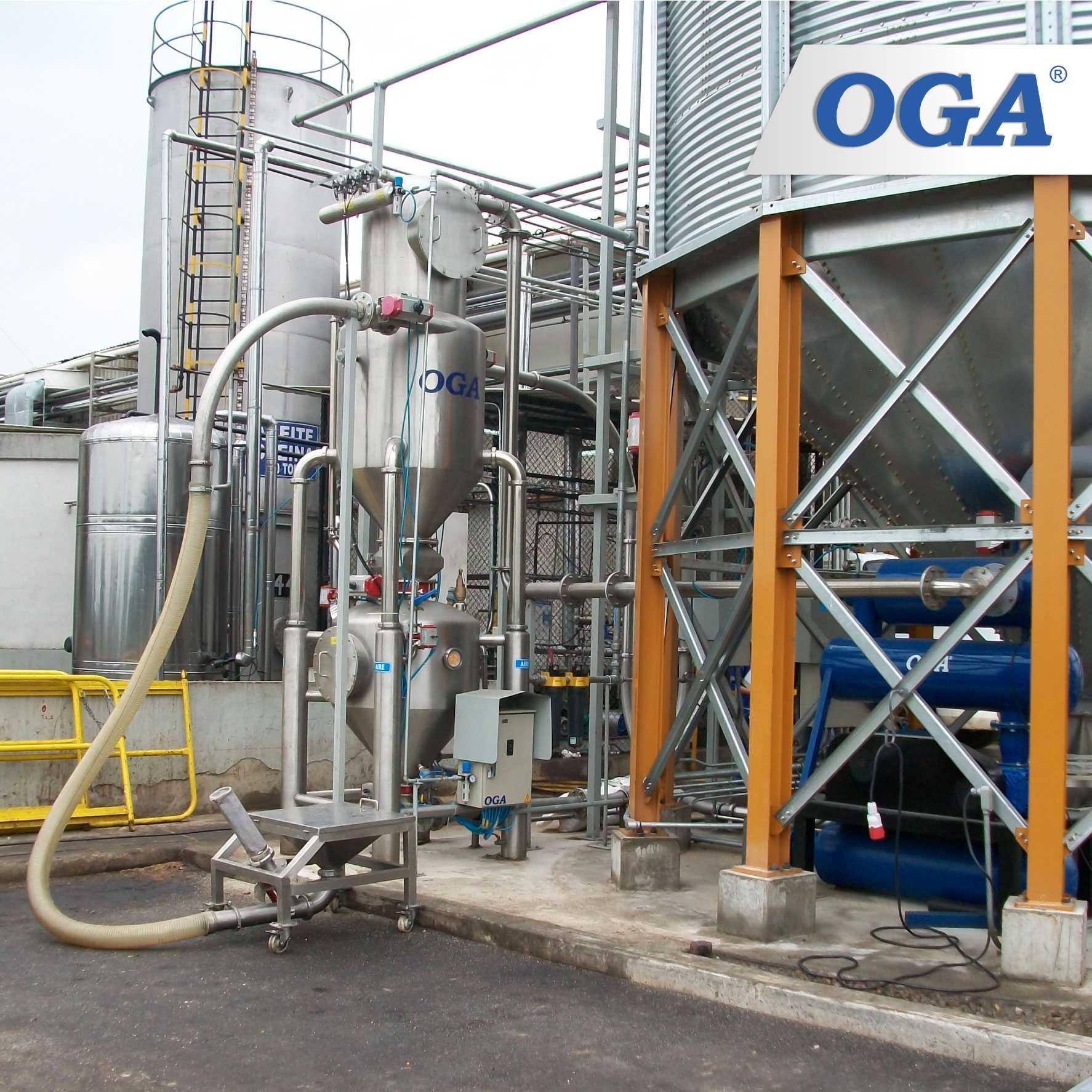

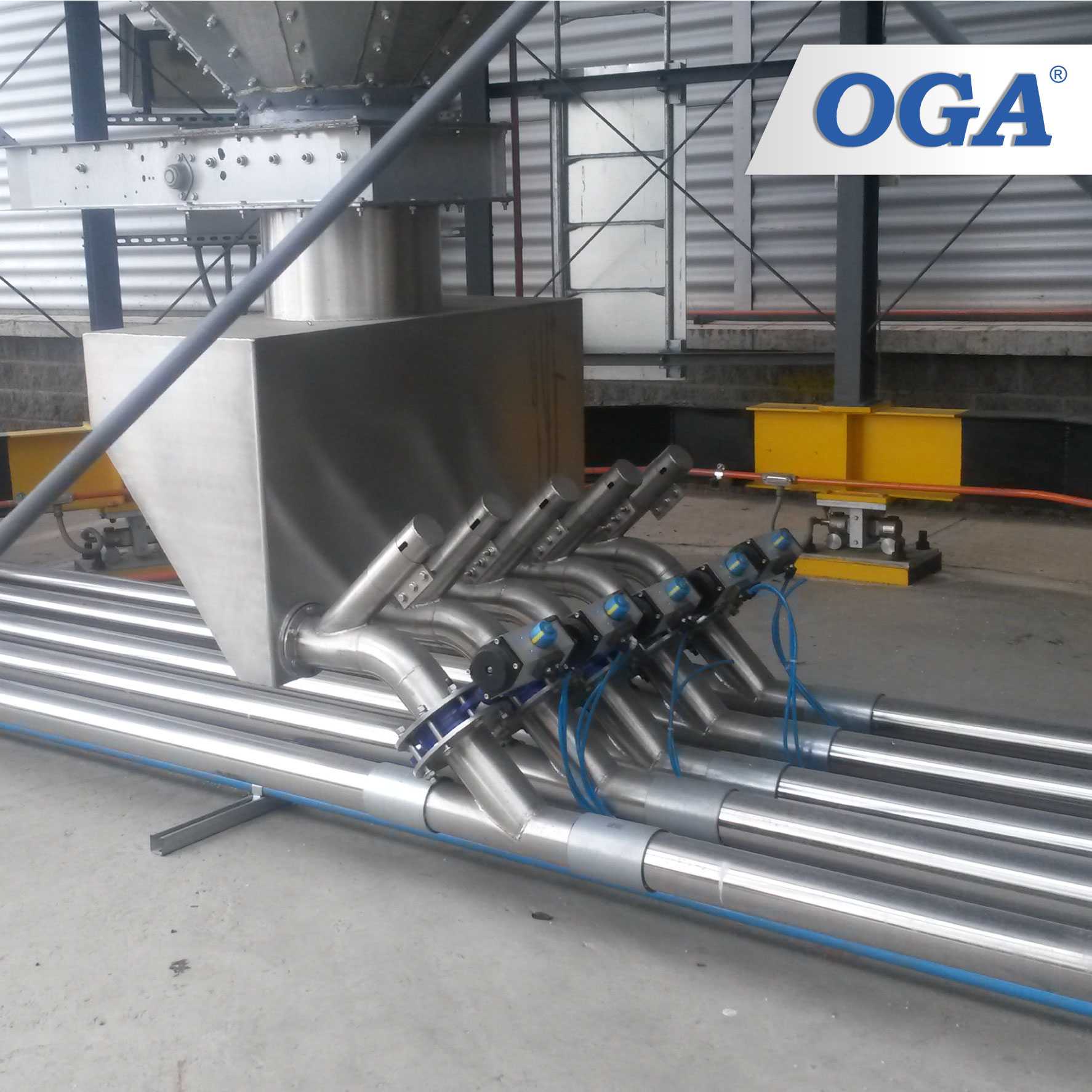
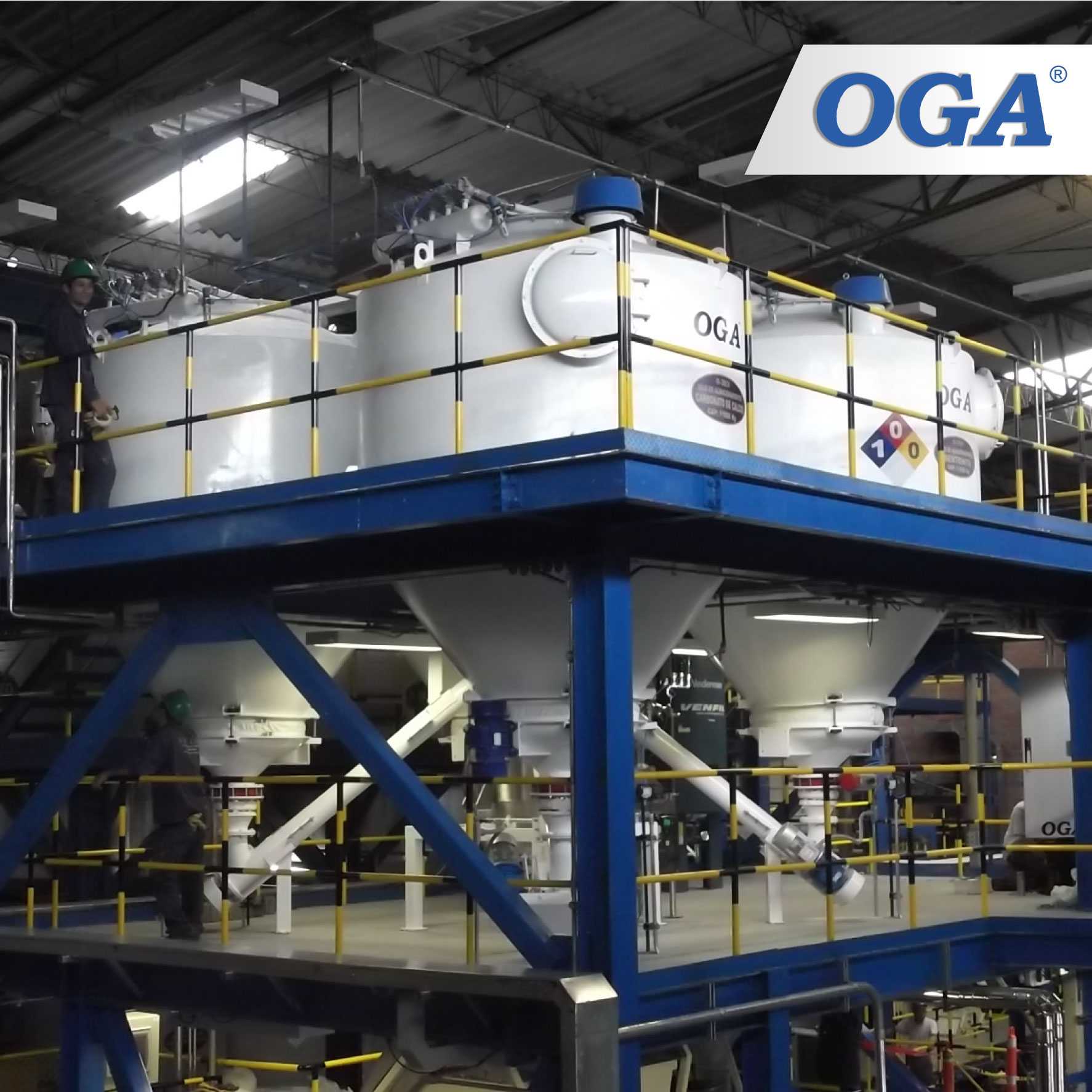

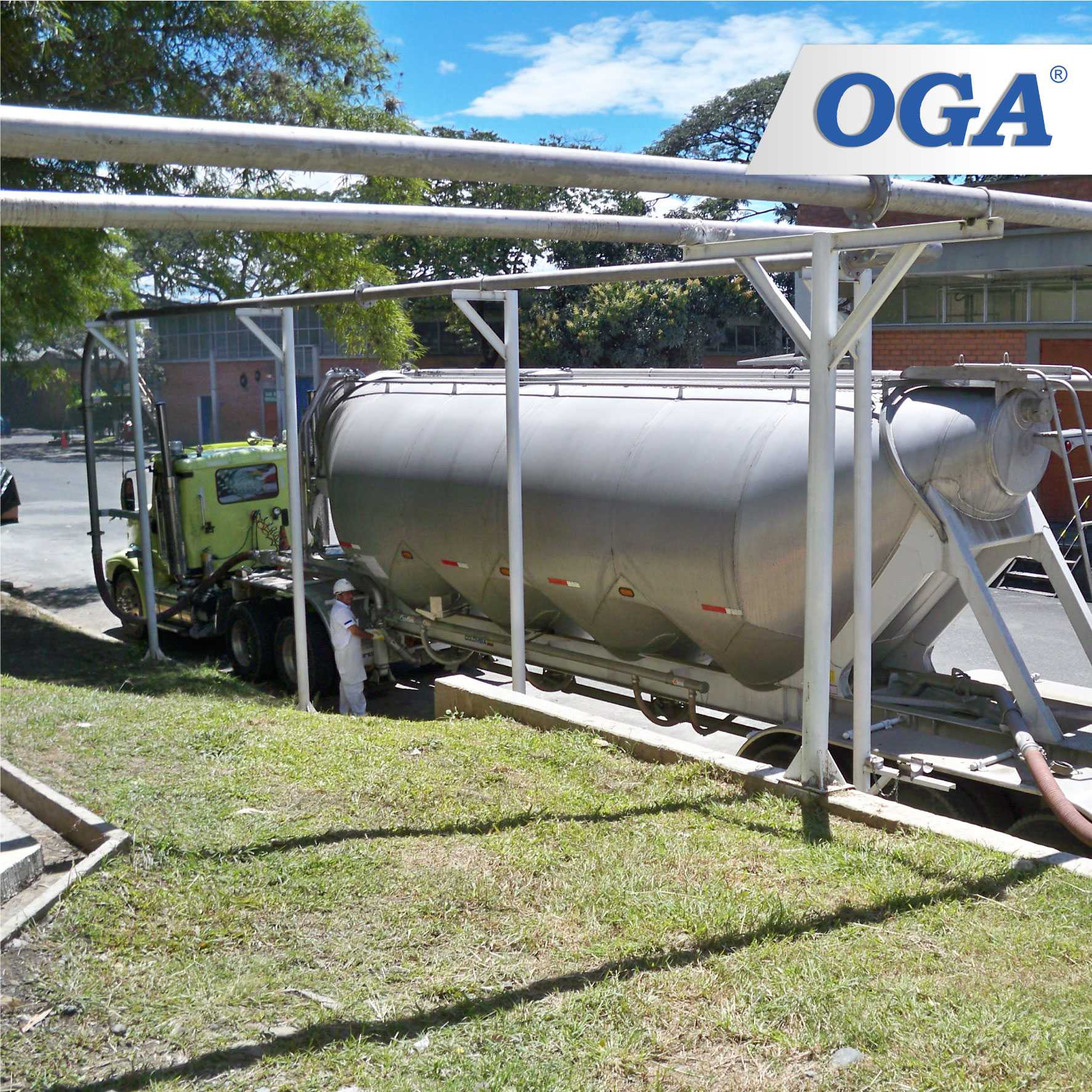
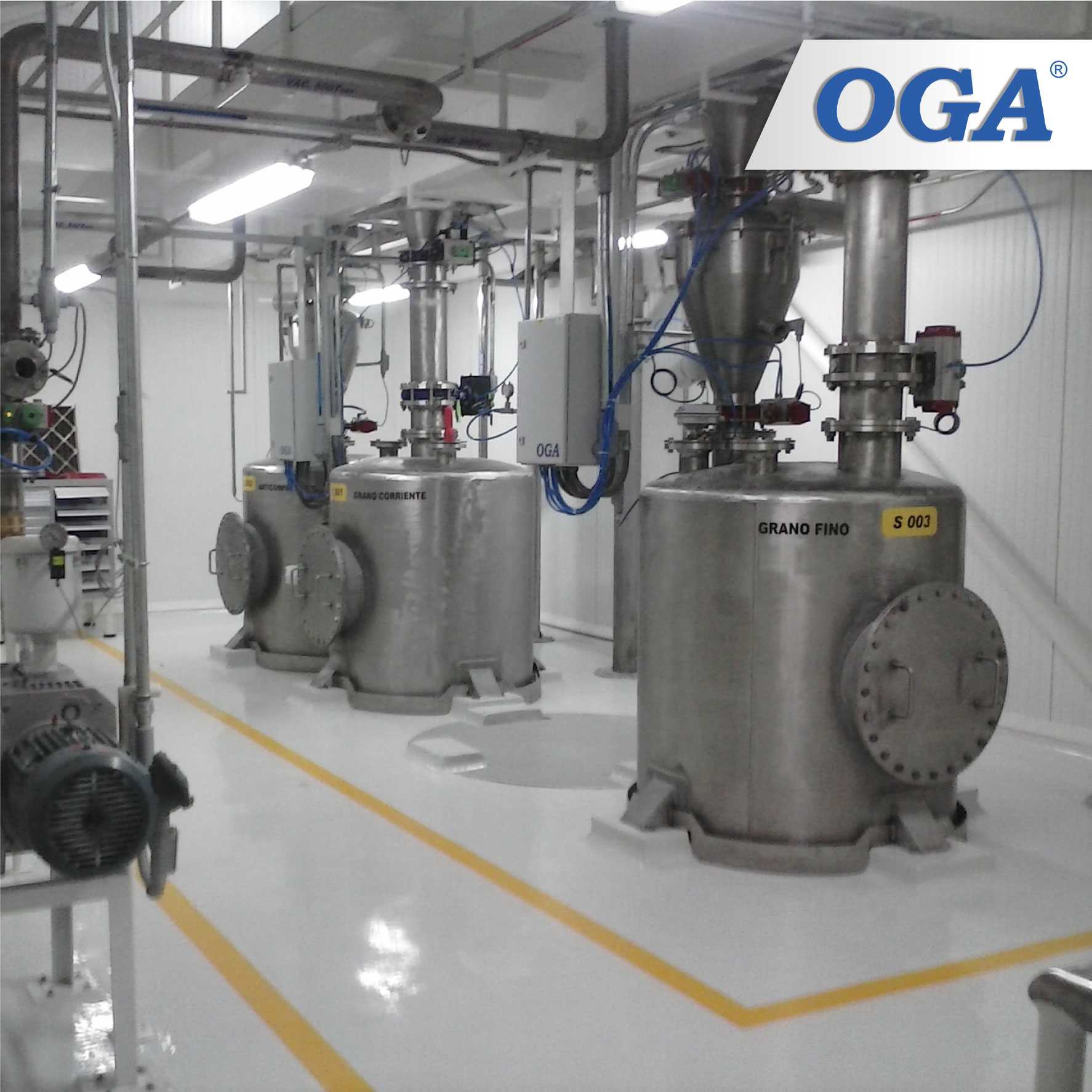

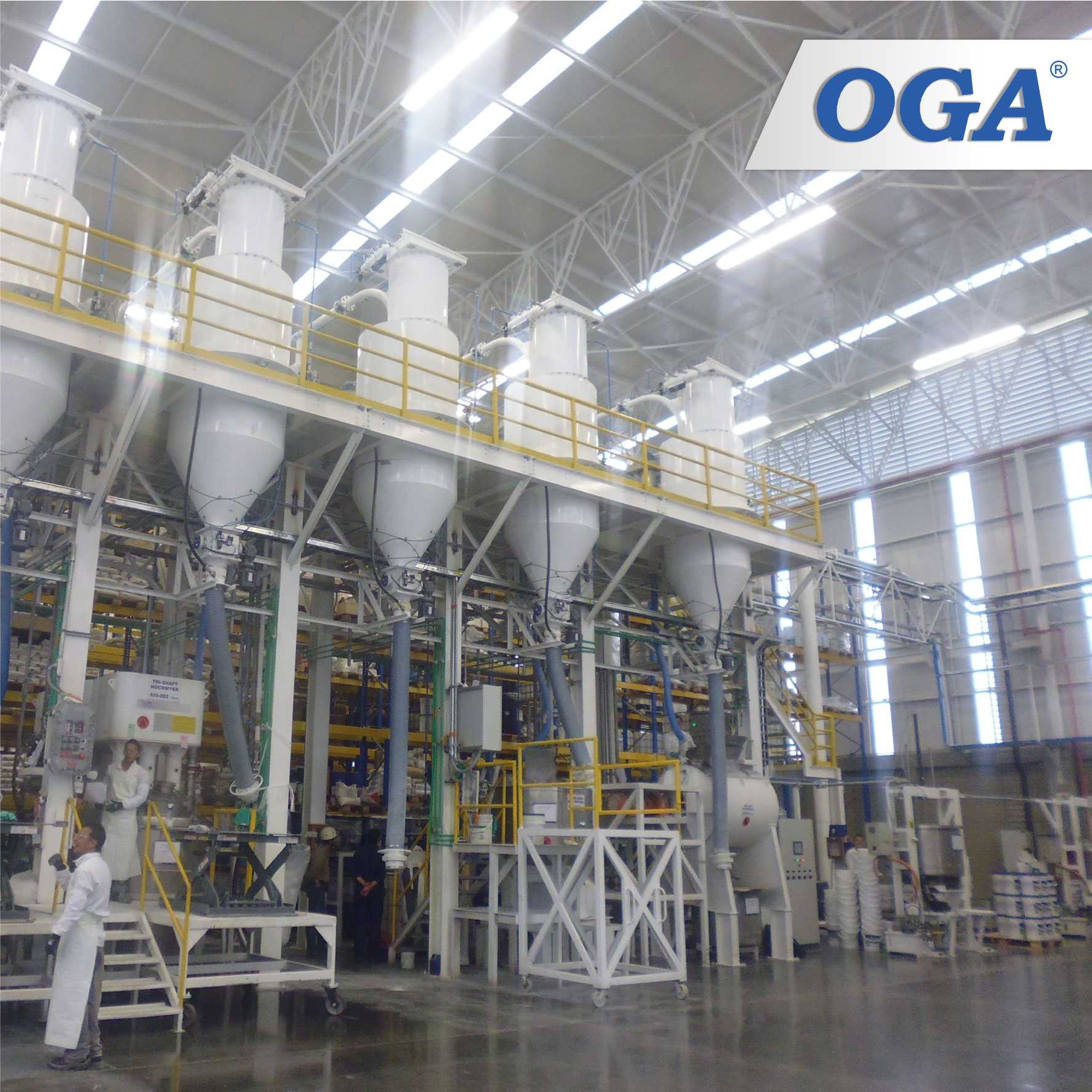
Gravity Force
Gravity force is the physical force exerted by the planet's mass on objects within its gravitational field. The effect of gravity explains why all bodies remain on the surface and do not float through the atmosphere. For this reason, in pneumatic conveying, this phenomenon is essential as it causes the sedimentation of solids inside the pipeline.
Differential Pressure Force (DPF)
The differential pressure force is the difference in pressure measurements between two points in a system; therefore, it is the force used to prevent a fluid from expanding. In pneumatic conveying, differential pressure is considered the resistance acting in the direction of the flow, toward the lower pressure.
Inertia Force (IF)
The inertia force is the force acting on a mass when a body is subjected to acceleration and is only detectable by what is connected to that accelerated system. In pneumatic conveying, inertia force is used to overcome the natural resistance to the movement of the flow.
Kinetic Energy
Kinetic energy is the work required to accelerate a body of a given mass from rest to a specified velocity. The body can maintain its kinetic energy unless its velocity changes after acquiring that energy during acceleration.
For pneumatic conveying systems, kinetic energy is the energy a mass possesses due to its velocity.
Pressure Energy
It is the energy that a mass of fluid possesses due to its pressure above atmospheric pressure, relative to absolute pressure.
Potential Energy
Potential energy is the ability of a system to perform work based solely on its position or configuration. It can also be considered as the energy stored in the system or as the measure of work that a system can deliver.
For pneumatic conveying systems, potential energy is the energy a mass possesses due to its position.









Properties of an Ideal Gas
Air or any other gas used for pneumatic conveying is compressed and, therefore, its expansion capability possesses intrinsic energy. The energy content of air for a specific state or conditions is determined by its properties.
The ideal gas model tends to fail at lower temperatures or higher pressures, when intermolecular size becomes significant.
Angle of Repose
The angle of repose of a granular material is the angle formed between the peak of the material cone and the horizontal base.
The factors that affect this angle are the material's moisture content, the homogeneity of the cone, and the material's particle size distribution.
Keep in mind that the angle of repose cannot exceed 90°.
Air Quality According to ISO 8573-8 (Parker)
In material handling systems using air, whether at low or high pressure, it is crucial to consider the quality of the air that comes into contact with the product. This classification is specified under ISO 8573.
Law of Energy Conservation
It is the amount of energy in any isolated physical system that remains constant over time, even though that energy may be transformed into another form. An example of this phenomenon can be easily observed when electrical energy is converted into heat energy in a heater.
When applied to pneumatic conveying systems, where there is a constant fluid flow in a pipeline, this law ensures that energy remains constant.
Law of Conservation of Matter
The conservation of matter states that matter is neither created nor destroyed; it is transformed. Therefore, in pneumatic conveying systems, the mass flowing through any section of the pipeline remains constant.
Particle Size Distribution
Granulometry is the distribution of particle sizes in a granular solid material.
The simplest granulometric determination method involves separating particles using a series of meshes with different aperture sizes, acting as filters for the grains. This setup is commonly known as a sieve column. However, for more precise measurement, a laser granulometer is used, which employs a laser beam that diffracts upon contact with the particles to determine their size.
Units of Measurement
The units in the International System of Measurement are micrometers or microns (µm).
Gravity Force
Gravity force is the physical force exerted by the planet's mass on objects within its gravitational field. The effect of gravity explains why all bodies remain on the surface and do not float through the atmosphere. For this reason, in pneumatic conveying, this phenomenon is essential as it causes the sedimentation of solids inside the pipeline.
Differential Pressure Force (DPF)
The differential pressure force is the difference in pressure measurements between two points in a system; therefore, it is the force used to prevent a fluid from expanding. In pneumatic conveying, differential pressure is considered the resistance acting in the direction of the flow, toward the lower pressure.
Inertia Force (IF)
The inertia force is the force acting on a mass when a body is subjected to acceleration and is only detectable by what is connected to that accelerated system. In pneumatic conveying, inertia force is used to overcome the natural resistance to the movement of the flow.
Kinetic Energy
Kinetic energy is the work required to accelerate a body of a given mass from rest to a specified velocity. The body can maintain its kinetic energy unless its velocity changes after acquiring that energy during acceleration.
For pneumatic conveying systems, kinetic energy is the energy a mass possesses due to its velocity.
Pressure Energy
It is the energy that a mass of fluid possesses due to its pressure above atmospheric pressure, relative to absolute pressure.
Potential Energy
Potential energy is the ability of a system to perform work based solely on its position or configuration. It can also be considered as the energy stored in the system or as the measure of work that a system can deliver.
For pneumatic conveying systems, potential energy is the energy a mass possesses due to its position.
Properties of an Ideal Gas
Air or any other gas used for pneumatic conveying is compressed and, therefore, its expansion capability possesses intrinsic energy. The energy content of air for a specific state or conditions is determined by its properties.
The ideal gas model tends to fail at lower temperatures or higher pressures, when intermolecular size becomes significant.
Angle of Repose
The angle of repose of a granular material is the angle formed between the peak of the material cone and the horizontal base.
The factors that affect this angle are the material's moisture content, the homogeneity of the cone, and the material's particle size distribution.
Keep in mind that the angle of repose cannot exceed 90°.
Air Quality According to ISO 8573-8 (Parker)
In material handling systems using air, whether at low or high pressure, it is crucial to consider the quality of the air that comes into contact with the product. This classification is specified under ISO 8573.









Law of Energy Conservation
It is the amount of energy in any isolated physical system that remains constant over time, even though that energy may be transformed into another form. An example of this phenomenon can be easily observed when electrical energy is converted into heat energy in a heater.
When applied to pneumatic conveying systems, where there is a constant fluid flow in a pipeline, this law ensures that energy remains constant.
Law of Conservation of Matter
The conservation of matter states that matter is neither created nor destroyed; it is transformed. Therefore, in pneumatic conveying systems, the mass flowing through any section of the pipeline remains constant.
Particle Size Distribution
Granulometry is the distribution of particle sizes in a granular solid material.
The simplest granulometric determination method involves separating particles using a series of meshes with different aperture sizes, acting as filters for the grains. This setup is commonly known as a sieve column. However, for more precise measurement, a laser granulometer is used, which employs a laser beam that diffracts upon contact with the particles to determine their size.
Units of Measurement
The units in the International System of Measurement are micrometers or microns (µm).

Density
Density is a property of matter that measures the amount of material compressed within a given space (degree of compaction). In other words, it is the amount of mass per unit volume.
It is important to note that each substance has a different density, which depends on its atomic structure and the arrangement of its molecules.
p = M/V
Apparent Density
The apparent density of a (heterogeneous) material is the ratio between its volume and dry weight, including any voids and pores it contains. This measurement is applied to porous, granular, and pelletized materials, among others.
Units of Measurement
International System of Units (SI)
Kilogram per cubic meter (kg/m³).
Gram per cubic centimeter (g/cc).
Kilogram per liter (kg/L).
Imperial System of Units
Ounce per cubic inch (oz/in³).
Pound per cubic foot (lb/ft³).
Pound per gallon (lb/gal).
Flow Rate
Flow rate is the amount of fluid that passes through a duct section per unit of time. It can also be identified as volumetric flow or the volume passing through a given area within a specific time unit. Qa = V/T
The forces that must be considered when calculating the flow rate in pneumatic conveying systems are gravity, differential pressure, and inertia.
Units of Measurement
International System of Units (SI).
m³/s = Cubic Meter per Second = 1000 L/s = 35.31 ft³/s.
L/s = Liters per Second = 0.001 m³/s = 0.03531 ft³/s.
Other Systems
m³/s = Cubic Meter per Second = 1000 L/s = 35.31 ft³/s.
L/s = Liters per Second = 0.001 m³/s = 0.03531 ft³/s.






